Rachel Neumeier's Blog, page 91
October 19, 2022
Earned versus Unearned Endings
So, when discussing the Scholomance trilogy, I said that I put it way above Uprooted or the Temeraire series, the former because of a much superior ending and the latter because the Scholomance trilogy is massively more tightly plotted. Various of you pointed to Spinning Silver and said that was your favorite of Novik’s books until the Scholomance trilogy bumped it down to second place. That’s one I haven’t read, and after your various comments about it, now I’m much more interested in it. But I thought I’d go back to Uprooted and explain why I loved it the first time I read it, but love it a lot less now, and why that’s different (very, very different) from the Scholomance trilogy. Then maybe those of you who have read Spinning Silver can evaluate that one on this particular axis.
Now, first, I should say briefly, that I really loved the first book of the Temeraire series and had no problem suspending (major) disbelief in the (extreme) ecological implausibility of having significant populations of giant dragons all over the place, especially Great Britain.
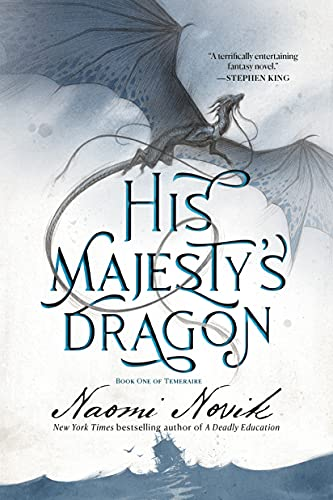
The story carried me over that hump. I loved the book and I thought the ending was fine. Then in the second book, I got bored with the long, long, long trip to China. Then, in some later book, I got bored with the LONG, LONG, LONG trip across the Australian desert for what (as I recollect) was basically no purpose. After that I think I read one more book? But I wasn’t very invested and quit. The problems here had to do with plot threads going off in various directions until the action diffused out into a mist of long journeys interspersed with random things I don’t remember very well. That’s a huge contrast to the Scholomance trilogy, where you read the third book and everything pops into clearer and clearer focus as you go, all the plot threads weaving tightly together into one cohesive picture.
So that was a big and important difference.
But the problem I had with Uprooted was totally different from the problem I had with the later books of the Temeraire series.
I loved Uprooted while I was reading it, straight through to the end, which … I did not love. It was too neat. It was too happy.
Yes, I love happy endings. But.
Yes, I particularly love redemption arcs. BUT.
In Uprooted, when we saw the finale of the redemption arc, that redemption was unearned. The ending was unjust.
The evil forest was WAY too evil to just pat it on the head and say all was forgiven and let’s all be friends now. I don’t remember the details about how everyone got into that mess in the first place. The part I remember is that the evil forest did A LOT of REALLY DIRE AND HORRIBLE stuff to innocent people for a LONG TIME and then, poof! That’s okay though! It’s all right! Let’s all be friends!
The horrible things the forest did were actually not okay, not remotely okay. The full story novel did not seem, to me, to lead to forgiveness or redemption in a believable or just way.
I can think of a few other stories that did not work for me in this exact way: An unjust ending, or sometimes an unjust plot twist, ruined the story for me beyond any possible retrieval.
For example, this one, which was at least nominated for awards and maybe won, I don’t remember:
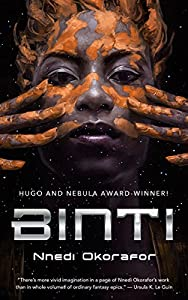
I had several problems with this story. I thought the protagonist’s voice sounded clinical rather than genuine, like an anthropologist telling a story she imagined someone might have lived rather than like someone living that life. Some other plot elements seemed peculiar and unbelievable. But the thing that absolutely ruined this story for me was that, well, sure, the meduse killed everyone on the ship except Binti, but that’s okay because … well, it’s all right because … I mean, really, you can’t blame the meduse because after all …
No. No, that is not okay with me. It wasn’t just that Binti finds this mass murder event okay, although that’s bad enough. Everyone else in the story also seems to shrug that off, and that was even worse. This plot twist was handled in a way that was deeply unjust. Could it have been fixed? Sure. Revamping the emotional reaction of the human characters would have done it even without changing a single thing about the plot. Writing Binti herself as a sociopath who doesn’t care a bit about other people would have fixed this problem, though it sure wouldn’t have made me like the story any better.
This one isn’t SFF, but:
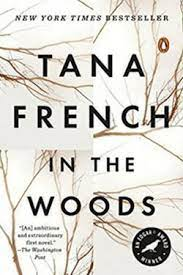
You may recall that I loathed this book. It’s beautifully written, I’ll say that. But I hated the way the protagonist slowly destroyed his life over the course of the novel, I hated the way the author took a perfectly good nonsexual male-female friendship and turned it sexual and then ruined it, I hated the way the opening mystery is left totally unsolved, and I absolutely detested the ending, in which the bad guy gets away with vicious murder and walks away scott free. That is the quintessential unjust ending. This is the first book of what appears to be a six-book series, and for all I know the story may still be going, but I will never read the second book. I don’t care how the author handles anything whatsoever. I don’t care if the protagonist ever puts his life back together. I don’t care whether he recovers his friendship with the female colleagues. I don’t care about the initial mystery. I don’t even care whether the murderer is ever brought to justice. The ending of the first book means I’m never picking up another book in the series OR another book by the author.
And my real point in this context is that this unjust ending alone, even if everything else had been great, would almost certainly have ruined the book for me.
I pause to note that In the Woods was a NYT bestseller, I see. Well, whatever. We all know that very popular books can be absolutely horrible.
What other kinds of books have endings that are not exactly bad — not necessarily bad — but are handled in a way that may be unjust?
Well, there’s The Dark is Rising series by Susan Cooper. I have very fond memories of that series, and I bet most of you do as well. I read it many times. But (spoiler!) when half the characters wind up forgetting everything important at the end, that’s a problem. It’s a problem with fairness — the author is not being fair to those characters and therefore the author is not being fair to the reader. That’s a kind of unjust ending that makes readers throw the book across the room and shout.
Really, I do feel Susan Cooper ought to have realized that everyone was going to hate that aspect of the ending.
Here’s a different one which the author pulled off surprisingly successfully: Diplomatic Immunity by LMB. Here, Miles goes through all that and then, boom, he’s unconscious for the climax and half the denouement. Bujold can pull that off because (a) Ekaterin is a great character, and (b) Bujold is just that good a writer. But it’s unfair to Miles. It was also unnecessary. She could perfectly well have handled that part of the book differently. I don’t think there was any important advantage to the plot to handling it the way she did. In fact, it made the ending harder to write, not easier.
In contrast to all the above, sometimes the ending is particularly excellent, and excellent in a way that provides … I’m not sure how to put this … that provides a more just ending than the reader thought was possible. The reader sees defeat coming and of course trusts that the author will have the characters pull victory out of defeat, and that happens, but in a way that is surprising and also perfect for this particular story.
I am in fact thinking of the ending, and here I mean the climactic ending rather than the epilogue-style ending, of the Scholomance trilogy here. The solution fits perfectly into the metaphysics of the story and it’s also right for all the characters involved, not just El and Orion, but everyone. I appreciated the quiet epilogue-style ending too — I almost always love epilogues — but that wasn’t the part that involved a surprising and fitting and just solution to the problem.
Here’s another one: in the Demon’s Lexicon series by Sarah Rees Brennan — which is a fairly dark series, and very intense, by the way — but it’s also a great trilogy. It’s got a lot going for it, including tremendous characterization and amazing dialogue and good worldbuilding, but right at the moment I’m thinking about the ending. Jamie is an important character from the beginning of the trilogy, but moves to a role that’s very central to the plot in the third book, even though he’s not a pov character at that point. I’m going to provide a spoiler about the ending, but I’ll keep it vague.
The important thing in this context is that (a) we don’t see the solution coming; (b) it fits the characters, the metaphysics, and the situation; (c) it’s a better ending than the reader probably expects — better for the characters — better for the minor characters, not just the important characters — better for the bad guys too, a lot of them, because (here’s the spoiler!) Jamie pulls them over the the right side. There’s a redemption arc we don’t see coming, buried beneath everything else that’s going on. This is amazingly great and also it’s a just ending, an earned ending, one that doesn’t feel like oh, never mind, all is forgiven when really, it shouldn’t be.
One more: in David Brin’s The Uplift War, a lot is going on, a lot of it important for humans. But the central problem isn’t exactly about humans, it’s about partially uplifted gorillas. Everything is difficult and complicated and it’s impossible to see how anything can possibly work out. And then, boom, it DOES work out, in a way that fits the characters and the world. The gorillas make their own decision, which no one saw coming, and one of the important characters exclaims something like, “I worked so hard for this to happen and never even knew that was what I was working for!” The reader immediately sees that yes, that’s right, this is exactly what needed to happen, it’s what everyone would have been working for except they hadn’t thought of it. It’s also just what the reader wants to have happen, even though the reader doesn’t know that until it does happen. It’s unexpected, but exactly right.
All this reminds me of a term that Tolkien (I think?) coined — eucatastrophe. Yes, this post here indicates that Tolkien is the one who coined that term.
In essence, a eucatastrophe is a massive turn in fortune from a seemingly unconquerable situation to an unforseen victory, usually brought by grace rather than heroic effort. Such a turn is catastrophic in the sense of its breadth and surprise and positive in that a great evil or misfortune is averted.
Heroic effort or grace, either is fine with me. And of course many fine stories don’t quite reach this level with their various endings and they’re still good and still have good endings. But a novel that heads for a terrible ending and then the author delivers by fiat an unearned happy ending rather than an earned happy ending — that’s not just unsatisfying. It feels wrong. It doesn’t fit. It feels like cheating. In Uprooted specifically, it feels disconnected from the story, as though the story has depth, but the ending is facile and shallow. I’m not sure I’m expressing this as well as I’d like to, so I’ll go back to the term that seems to fit best to me: It feels unjust.
And it turns out that this is a big problem for me, bigger than I realized at the time. Over time, the ending of Uprooted bothered me more and more and this ended by coloring the whole story, which I now like much less than I did when I first read it. I re-read the book again, later, and finally figured out what the problem was, which I’m not sure I understood the first time I read it. I doubt I’ll ever re-read now.
So … I guess that’s a really long discussion about an important quality where a novel may succeed far better than expected or fail more profoundly than expected. But I think I’ll wind up bringing this back down to a simple question: How about Spinning Silver? If you’ve read it, how did you like the ending?
Please Feel Free to Share:






The post Earned versus Unearned Endings appeared first on Rachel Neumeier.
October 17, 2022
Not the actual genetics powerpoint, but here:
Enough of you (two so far!) expressed interest, so here are a couple questions that I may use on the genetics problem set. I’m still putting the final problem set together, but these have good pictures that go with the problem.
These problems involve situations laid out in the powerpoint, so you’re not supposed to necessarily feel comfortable with this just by reading the questions. This sort of thing is meant to follow the lectures and then you’re supposed to have the powerpoint as a reference.
But I hope this will give you a feel for the sorts of things I would like students to be able to do after this set of lectures!
Also, if you recall, in Black Dog Short Stories, there’s a brief “nonfiction” essay about black dog genetics. That is actually a good look at how I handle the half-dozen terms that are relevant to introductory genetics — gene, allele, heterozygous, homozygous, genotype, phenotype.
6) In dogs, the merle color is caused by a completely dominant allele at the M locus. This allele turns any black areas of the coat to a blurred, patchy, black-gray-silver, and any patches of brown to a patchy, diluted reddish-tan. Here is a merle Cardigan Welsh Corgi, looking over her shoulder.
Merle dogs are Mm. Non-merle dogs are mm – they are just whatever color their other color genes specify. MM dogs are largely white. They often die at birth. If they live, they generally have severe eye and ear defects and are largely or completely blind and deaf. This trait can therefore best be treated as a lethal dominant.

6a. If two merle dogs are crossed, what is the chance that any puppy conceived will be MM and therefore die or be seriously impaired?
6b. If two merle dogs are crossed, what proportion of non-impaired puppies would be merle?
6c. What cross could a reputable, ethical breeder use to produce merle puppies without risking the accidental production of crippled puppies?
7) In rabbits, one gene with four alleles controls a set of colors, as shown below. Dominance is complete in order from left to right.
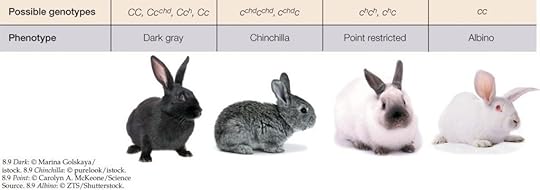
7a. How many alleles can a specific, individual, genetically normal bunny possess?
7b. List all the different genotypes that could result in the black phenotype.
List all the different genotypes that could result in the chinchilla phenotype.
List all the different genotypes that could result in the Himalayan phenotype.
List all the different genotypes that could result in the albino phenotype.
7c. If you cross a chinchilla rabbit carrying albino to a black rabbit carrying Himalayan, what genotypic and phenotypic ratios do you expect in the offspring?
7d. If you cross a chinchilla rabbit whose mother was albino to a Himalayan rabbit whose mother was known to be Cchc, what genotypic and phenotypic ratios do you expect in the offspring?
Please Feel Free to Share:






The post Not the actual genetics powerpoint, but here: appeared first on Rachel Neumeier.
Update: Tasmakat
So, last week I said I could see the light at the end of the tunnel. How is that tunnel looking now?
Progress over the week last week was really slow. I had a lot of other stuff going on, including grading the second Gen Bio test, which took an entire evening that I’ll never get back, sigh. (I was happy to see that two students brought their scores up A LOT compared to the first test; alas, at least one student did much worse than on the first test.) I will have lab reports to grade … sometime … but they are going to be so deeply boring and time-consuming that I’m putting that off till … I don’t know. Later. Tonight or tomorrow morning, I will need to set up a lab practical, which is amazingly annoying, but will at least be fast to grade. Traditionally every student bombs the first lab practical. I’m hoping some of them beat that expectation by a lot.
I also completed the extensive revision to the genetics powerpoint that will accompany a series of lectures. I took out almost all the pea plants and all the Drosophila and whatever else, and put in dogs, horses, cows, cats, just threw in tons of mammals everywhere, which increases the visual appeal tremendously. Sure, you can use pea plants to talk about straight-up dominance and recessiveness, but you can perfectly well use copper toxicosis in Bedlington Terriers and then you can add pictures of puppies and that is WAY cuter than pea plants.
I do have a couple of slides about blood types because, sure, that’s a fine example of multiple alleles plus codominance, but you know what else is a fine example of multiple alleles? The four alleles at the Agouti locus that helps set base color for dogs. I used a Belgian Tervuren to show red sable, a Keeshond — that’s a lovely breed that should be a thousand times more popular — for wolf sable, a Shiba for black-and-tan, and a German Shepherd for the surprisingly rare recessive black. (Most breeds have dominant black from the K locus, not recessive black from the Agouti locus.) And so on, right through the whole presentation.
I also added roughly ten thousand slides that walk students very carefully step by step through Punnett Squares and should help everyone avoid the common mistakes students make with all this material. (Well, everyone who pays the least bit of attention, anyway.) Tons of places where the slide says Do this now and I pause to give everyone a chance to try it themselves before moving on. Everything got rephrased and clarified, and the most crucial text is now RED to help it pop. The overall effect is to increase the number of slides A LOT, improve the clarity of the subject A LOT, and slow down the lectures A LOT, all to help everyone get this often challenging subject that I happen to really love.
Everything in this presentation is true, too, none of this nonsense about “brown eyes are dominant to blue eyes” and other total garbage that is too often presented in kindergarten genetics and gives students a thoroughly misleading idea of the subject. I should add, I’ve never had a chance to teach genetics using powerpoint — we drew stuff on whiteboards last time I did this. But I’ve taught this subject both in the classroom and to random people who are breeding dogs and want to know more about it and I’m very, very familiar with the most common misconceptions and mistakes. Every single student who wants to learn this is going to learn it.
I greatly enjoyed putting this presentation together and I’m really looking forward to getting to it, probably next week. I’m adding a big genetics problem set too, which will help students who care to take it seriously because I’m putting a lot of points on it, probably equivalent to a whole lab practical. But all this did of course take a good deal of time.
So how did that affect progress with Tasmakat?
I wrote just four thousand words during the week last week. OUCH. But then Saturday and Sunday, I made up for it, so I wound up writing 16,000 words total for the week. Where are we now?
–The important conversation is long over
–We are moving toward the action climax
–I wrote a scene that I didn’t see coming. Could it come out again? Sure, maybe, possibly. It’s not a crucial scene. But it sets Ryo up to have a specific thought in the next scene. That thought provides, I hope, clarity about what is going on with Aras, who is, I have to say, having a tough time right now, though he’s barely aware of that himself. Remember that all this is difficult to handle because we can only see Aras through Ryo’s pov. That means that it’s really important for Ryo to explicitly realize certain things so that the reader can understand what’s happening.
–That next scene has also been written, so that moment of clarity has occurred. That’s where we are right now.
What’s coming up:
–Clarification of the essential problem. I mean the action plot here.
–Movement toward dealing with the essential problem.
–Dealing with the essential problem.
This is three scenes, one each. As far as I know. I mean, I could very easily write another scene I don’t see coming. But at the moment, that’s what I think is coming up. That will take us into the scenes I’ve already written and therefore straight to the second part of the relationship climax, which I believe is the last thing we’re going to hit before the denouement.
We’re therefore still in the tunnel, BUT, maybe halfway through it. The light at the end is the denouement, by the way. I’m going to really love writing that! I just have to get through the action climax first. Will I get through that this week? Of course I don’t know, but I think overall this week should be calmer than last week, so I hope so.
Length: Tasmakat just hit 296,000 words. That means it’s exactly the same length right now as the Death’s Lady trilogy, which was previously the longest single work I’ve ever written. BUT, that was the final length for Death’s Lady, while this is the draft length for Tasmakat. This one will go longer, obviously, but I think they’ll probably be comparable in final length.
I will just mention, I started seriously working on Tasmakat in the middle of June. At the time I picked it up, I had 40,000 words written. This was the beginning plus something that now occurs in about chapter 12 or so rather than a smooth hundred and thirty pages. It’s now the middle of October. That’s 256k in four months, or 64,000 words per month, so even though it’s been difficult since the Gen Bio class started, really, I’m feeling pretty good about that.
Please Feel Free to Share:






The post Update: Tasmakat appeared first on Rachel Neumeier.
October 14, 2022
Fantasy Subgenres
Ah, the continual and entertaining project of sorting out subgenres! This is a post from Book Riot: IT’S FANTASY ALL THE WAY DOWN: A FANTASY SUB-GENRES PRIMER
It’s smart to add the word “primer” to this post title. That suggests that you’re not going to try to get ALL the subgenres lined up in a neat row, which is an impossible task. No, this is a primer! It’s just meant as a starting point! Good idea. What subgenres does this Book Riot post pull out as basic to the genre? All the ones you’d expect, probably: High, Low, Epic, Fantasy of Manners — that one is interesting! — Historical, Grimdark, Magical Realism, Paranormal, Urban, Portal — oh, I wouldn’t include that as a BASIC subgenre. Also Fantasy Romance, SF Fantasy.
I’d say that Fantasy of Manners — which must mean anything in a Pride and Prejudice style — is probably a sub-subgenre under “Historical.” But this is still an interesting category, one I hadn’t thought of particularly, but agree that it’s reasonable to break it out of the main subgenre. The examples given in this Book Riot post are Zen Cho’s The Sorcerer to the Crown, India Holton’s The League of Gentlewomen Witches, and Oliva Atwater’s Half a Soul. I’ve read none of them. What leaps to mind for me is Tooth and Claw by Jo Walton, for perhaps obvious reasons.
But what subgenres would you consider essential to a primer on fantasy subgenres? Because, after writing various recent posts on positive fantasy, such as here, I think I’ve come to disagree in a fundamental way with this Book Riot post and basically all other lists of subgenres as well.
Here are the basic subgenres I see in Fantasy:
1) Epic fantasy. Secondary world, big events, broad scale, almost certainly a quest structure to the plot, very likely multiple points of view. This is NOT a synonym for high fantasy. Although a lot of epic fantasy is indeed high fantasy, other epic fantasy is grimdark. Also, lots of high fantasy is not epic at all! Plenty of high fantasy is much smaller in scope and more intimate in focus. Epic fantasy has to be epic!
Great examples of epic fantasy:
Eternal Sky by Elizabeth Bear. Here’s my review of the first book. It’s a great trilogy, and it definitely has all the above characteristics. I think this exemplifies epic fantasy.
Freedom’s Gate trilogy by Naomi Kritzer. Here’s my review of the trilogy, which I loved very much. Like Novik’s Scholomance trilogy and “Katherine Addison’s” The Goblin Emperor, the Freedom’s Gate trilogy is so good that when I pause to think what I would have done differently, I really have trouble thinking of anything.
The four-book Inda series by Sherwood Smith, which I once used to define epic fantasy. I loved this quadrilogy, but I’ve only read it once. I should read it again, maybe after reading all the Norsunder War books Sherwood is working on now. This isn’t my favorite of her works, but it’s up there. The Inda series is a LOT more approachable for me than some of her other works because the focus on Inda is tighter, there are fewer pov characters overall (still more than one!), and I like all or most of the pov characters.
The closest I’ve come is Winter of Ice and Iron. As a single standalone book, I think Winter might just barely fit the category. When we think of epic fantasy, we think EPIC, and it’s hard to really do EPIC in one novel.
2) Adventure fantasy. When you think, “Is there something like SF space opera, but fantasy?” the answer is yes, and I think the best term for that is adventure fantasy. Secondary world. Scale can be small, intimate. Doesn’t have to involve any kind of quest, but it does involve action. May have a fast pace. Can easily take include romance or other relationships, but the adventure is the focus. There are so many books in this category that I’m throwing darts at a universe of titles to pick any, but fine:
The Sunwolf and Starhawk books by Barbara Hambly, and in fact most of her fantasy probably falls into this category.
The Alanna series by Tamora Pierce is adventure fantasy.
Most of my books probably fall into this category. The Floating Islands, for example.
3) Urban fantasy. Smaller scale, smaller timeframe, high tension, solving a mystery structure to the plot, probably just one or two points of view. Takes place in a city environment (probably). Setting derived from a contemporary setting (probably). Includes vampires, werewolves, or various other supernatural elements of that sort (probably).
One of the series that springs to mind for UF is The Dresden Files by Butcher. Though I hear he got many, many details about Chicago very wrong.
I’ve always somewhat reluctantly put Black Dog series in this category, even though almost none of it takes place in a city. If a series includes a contemporary setting (or anything close to contemporary), and involves vampires and shapeshifters, and romance isn’t front and center, then it’s probably UF no matter whether the setting is urban or rural. I realize this is not ideal, but there we are.
4) Paranormal romance. I know this intersects with UF. Lots of same characteristics, but centers a romance. Is that enough to separate it out as a different subgenre? I kind of think it is, because whatever else is going on, the structure of the plot is a romance structure — the beats are romance beats.
The Hidden Legacy series by Ilona Andrews. I realize one can go back and forth with a lot of Ilona Andrews’ books: UF or paranormal? The romance is so central in this series that I think it’s paranormal even though I don’t think there are the standard vampire/werewolf elements. Also, in my opinion, the authors are really at the top of their game with this series, which I love very much. Did you know the the fifth and sixth books are out? I did not, until I went to get the link for the first book in the series. I’m surprised I’m that far behind, but I see the sixth book just came out this past August and I’ve been busy. The first three books form one unit, by the way, and the second trilogy forms another set. I’m currently re-reading the Murderbot novellas and novel, because I really do not want to be distracted from Tasmakat, but I think these are up next. I’ll have to re-read the 4th book to get back up to speed — fortunately, re-reading is exactly what I’m in the mood for anyway.
5) Contemporary fantasy. Takes place in our world or a very close approximation of our world, in the present day or close to it. Not UF or paranormal romance, which means no vampires, werewolves, or anything like that. Anything else. Or maybe this is the actual subgenre while a lot (but not all) of UF and paranormal fit into contemporary fantasy as sub-subgenres? Regardless, there are certainly other works which are contemporary fantasy but not UF or paranormal.
Now, when I was trying to come up with examples for this category, I thought of a couple of books that only sort of fit, but I’m going to put them in here with links because they are VERY HARD TO FIND. That is, searching “Powers Burton” doesn’t do it, and searching “Bladesmith Hetley” doesn’t do it either. It was so annoying to find these I went to my personal orders and searched for them there, then clicked through to the Amazon pages. This is a duology, but though the author published these two books under one author name, he never got Amazon to link the two books, so seriously, that’s a problem. But here they are: Powers and also Dominions by James A Burton. He has also published fantasy novels as James A Hetley, but the one of those I tried didn’t appeal to me and I DNF it. But I loved Powers and Dominions. Here’s my review of Powers.
However, though they start off in a contemporary (and urban) setting, they don’t stay there. So I should come up with some other examples of contemporary fantasy. Okay:
The Raven Boys by Maggie Stiefvater, and for that matter, her excellent The Scorpio Races. I had some issues with the way the former series ended, though I nevertheless really enjoyed this quadrilogy. I loved practically everything about The Scorpio Races, which was one of my favorite books of the year when I first read it. It’s been some time. I should (sigh) re-read that sometime, along with the vast number of other books I’d like to re-read. Anyway, both are excellent examples of contemporary fantasy that is neither UF nor paranormal.
6) Magical realism, and here I always think of A Winter’s Tale by Helprin, which is my favorite magical realism fantasy ever. The rating on Amazon is 3.7, so I guess this is a love-it-or-hate-it book. It’s certainly long and leisurely. It took me a long time to appreciate it. In fact, I read it multiple times at different ages and finally loved it, but certainly not the first time I read it.
When I think harder, I add Sarah Addison Allen, who writes those lovely magical realism romances, such as The Peach Keeper. Her writing is so lovely.
The day Paxton Osgood took the box of heavy stock, foil-lined envelopes to the post office, the ones she’d had a professional calligrapher address, it began to rain so hard the air was as white as bleached cotton. By nightfall, the rivers had crested at flood stage, and, for the first time since 1937, the mail couldn’t be delivered. When things began to dry out, when basements were pumped free of water and branches were cleared from yards and streets, the invitations were finally delivered, but to all the wrong houses. Neighbors laughed over fences, handing the misdelivered pieces of mail over fences to their rightful owners with comments about the crazy weather and the careless postman. The next day, an unusual number of people showed up at the doctor’s office with infected paper cuts because the envelopes had sealed, cement-like, from the moisture. Later, the single-card invitations seemed to hide and pop back up at random. Mrs. Jameson’s invitation disappeared for two days, then popped back up in a bird’s nest outside. Harper Rowley’s invitation was found in the church bell tower, Mr. Kingsley’s in his elderly mother’s garden shed.
If anyone had been paying attention to the signs, they would have realized the air turns white when things are about to change, that paper cuts mean there’s more to what’s written on the page than meets the eye, and that birds are always out to protect you from things you don’t see.
But no one was paying attention. Least of all Willa Jackson.
I just adore Sarah Addison Allen’s books, though I grant, some are better than others. I loved The Peach Keeper, I loved Sugar Queen and Garden Spells, my favorite is actually The Girl Who Chased the Moon. Her most recent book was something of a disappointment to me. But … Oh, look, her most recent book Other Birds just came out August. I’d forgotten it was on the way. FINE. I’ve picked it up.
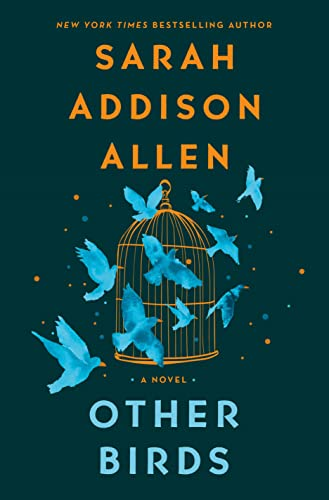
Down a narrow alley in the small coastal town of Mallow Island, South Carolina, lies a stunning cobblestone building comprised of five apartments. It’s called The Dellawisp and it’s named after the tiny turquoise birds who, alongside its human tenants, inhabit an air of magical secrecy.
When Zoey Hennessey comes to claim her deceased mother’s apartment at The Dellawisp, she meets her quirky, enigmatic neighbors including a girl on the run, a grieving chef whose comfort food does not comfort him, two estranged middle-aged sisters, and three ghosts. Each with their own story. Each with their own longings. Each whose ending isn’t yet written.
Wow, I let myself get totally distracted. What was the topic again? Oh, right, subgenres of fantasy. Okay, onward!
7) Fairy tales, and for this subgenre I’m inclined to include straight-up retellings such as Beauty by Robin McKinley (still and always a great favorite of mine), and also novels that are told in a fairy-tale way but aren’t in any sense a retelling, such as my debut novel, The City in the Lake.
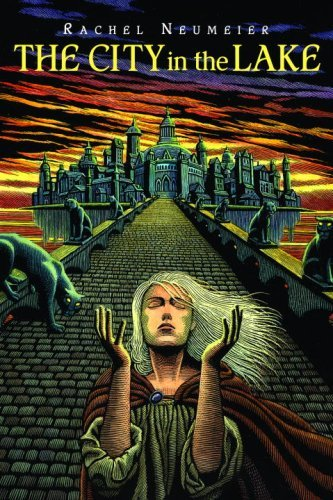
Fairy tales have a certain feel to them and a certain kind of magic and certain tropes, all of which are different from adventure fantasy or epic fantasy. Patricia McKillip wrote fairy tales such as The Changling Sea as well as epic fantasy such as the The Riddlemaster trilogy. In a fairy tale, we get enchanted forests or enchanted countries, and inexplicable magic, and if an animal asks you for help, probably you should help. I very much love fairy tales, but, though I think The City in the Lake worked really well — it’s still one of my personal favorites — it’s hard for me to capture the fairy-tale feel in a novel and I don’t think I’ve managed it as well again.
8) Science fantasy, which is of course fantasy with technological handwaving. It’s fantasy that sort of looks like science fiction and has some science fiction elements, but is really fantasy. Pern, I’m looking at you. It’s been a long time since I read these, and I think the original trilogy plus The Harper Hall trilogy are by far the best. But I admit, I haven’t read them all. I’m mildly tempted now to go try The Masterharper one. Have any of you tried it?
Anyway, science fantasy: slightly disguised fantasy with a few hand-wavy science fiction elements around the edges. Sharon Shinn’s Archangel is another excellent example.
9) Historical fantasy. This one is too obvious to need any kind of description. Historical setting, fantasy, boom, there you go. Whenever I think of this category, I think somewhat wistfully of Judith Merkle Riley’s Margaret of Ashbury trilogy. It’s superb. Or rather, the second book is superb. I bought it used, read it with delight, added the other two to my TBR pile, and somehow I’ve don’t believe I’ve ever read the whole trilogy in order. This is absolutely ridiculous. You know what, even though I have the first book in paper, I’m getting it now as an ebook because maybe that way I will FINALLY read it.
Also, sure, Fantasy of Manners. I do like that notion for a sub-subgenre.
10) Not sure what other subgenres I think are fundamental, if any.
I agree that stopping at nine is not aesthetically satisfying. Please suggest another fundamental subgenre. But before you do that, here’s a different, orthogonal method of categorization that I think takes out of consideration a lot of possible subgenres. I mean, I’m sure you will have noticed a lot of possible subgenres missing from the list above. That’s because I’m sort of thinking that these aren’t subgenres, but tones or styles — one might even say categories of themes — which can and do get used within multiple subgenres. These include: Positive fantasy, high fantasy, gritty fantasy, dark fantasy, horror fantasy, and grimdark fantasy.
The above list doesn’t include low fantasy because that particular term is SO badly defined that it’s utterly useless. The term “low fantasy” means radically different things to different people — contemporary setting to some, gritty to others, small-scale events or slice-of-life to others. There’s no convergence, no agreement, not even any overlap in meaning. The term is just entirely useless and is probably going to stay that way for the foreseeable future.
But the others … what do you think? It seems to me that when one says “Epic Fantasy,” one can equally well mean Joe Abercrombe’s grimdark First Law trilogy as Elizabeth Bear’s Eternal Sky trilogy or Mckillip’s Riddlemaster trilogy. They’re all epic. The difference isn’t in whether they’re epic or not epic. The differences are in tone, style, and theme, not epic scale.
The same goes for Adventure Fantasy. Scott Lynch’s Lies of Locke Lamora series is almost (but not quite) too gritty for me, but it’s adventure fantasy just as much as, I don’t know, okay, just as much as the otherwise totally different Wings of Fire series by Tui Sutherland. I mean, there’s absolutely no overlap in tone. They might as well be in different genres. They’re nothing alike. But I think they’re both Adventure Fantasy.
And so on. You can’t write a gritty novel in the Fairy-Tale Fantasy subgenre. But you can write a story that’s high fantasy, dark fantasy or probably even grimdark fantasy and have them all belong to the Fairy-Tale Fantasy subgenre.
I think I’m leaning toward preferring to define fantasy by terms that indicate tone, style, and theme rather than subgenre or sub-subgenre. I really enjoy every subgenre of fantasy. I’m not picky about subgenre! I’m picky about tone, style, and theme. Rather than saying “This is an epic fantasy,” I’d rather say, “This is positive epic fantasy” or “This is epic high fantasy” or “This is dark epic fantasy.” That gives me a MUCH MUCH clearer idea of which particular epic fantasy trilogy I might like to start and which I might not be in the mood for, or might want to avoid forever. Two terms, one for tone and the other for subgenre, that’s what I want.
I guess the first part is getting people to agree that “high fantasy” is a tone and style, not a subgenre, so I’m not holding my breath. But I’m going to make at least a moderate effort to try using this kind of categorization myself and just see how it works in practice.
Please Feel Free to Share:






The post Fantasy Subgenres appeared first on Rachel Neumeier.
October 12, 2022
I don’t have time to write a real post today, so —
Here, have an interesting Twitter thread about the English Language:
Please Feel Free to Share:So there's a particular quirk of English grammar that I've always found quite endearing: the exocentric verb-noun compound agent noun.
— David Thomas MOORGUE (@dtmooreeditor) September 12, 2022
It appears in a definite, remarkably narrow period – not more than 150, 200 years – before dying out, leaving loads of legacy words in its wake.







The post I don’t have time to write a real post today, so — appeared first on Rachel Neumeier.
October 10, 2022
Update: Tasmakat
So, I could have titled this post Tasmakat: The light at the end of the tunnel.
I have to say, it worked really well to skip everything transitional and everything less clear to me and head straight for the scenes that have been clear in my head for the past year. Of course time was still limited, but I still wrote 20,000 words last week and, to my surprise, suddenly feel like I’m closing in on an actual finished draft. I mean, there’s a fair bit to do, I guess? But comparatively speaking, I’m practically at the end.
It may not surprise you to know that I leaped past (a) a transitional travel scene, (b) a scene where we have an important chat with someone, (c) the transition toward the huge confrontation of the climax, and (d) the actual climax of the book. I mean the action climax. The battle scenes, though I’m not sure how much actual battle is going to occur there.
What I actually hit was (a) the big revelation and the decision point; then a big leap forward and (b) the first part of the relationship climax of the plot, (c) the following scene, and (d) the beginning of the second part of the relationship climax of the plot.
Over the past ten years or whatever, it’s become very clear to me that I’m seldom interested in big battle scenes. They can be fun when I get to them and finally figure out what I’m doing in them, but I’m not that focused on them. I don’t know what I’m going to do with those scenes until I get there. Then I take the dogs for a long walk and think hard and hopefully come up with the basic plotline of the battle.
And I don’t care about villains, not true villains, except inasmuch as opposing villains leads to more important things happening. When I wrote Tuyo, the scenes where we met Lorellan were almost the last part I wrote. I got to that meeting, leaped forward and wrote the escape scene and a lot of the rest of the book, then went back and did that meeting and subsequent events. So, this part of Tasmakat worked like that. I have taken more notes about the transition toward the action climax and about the action climax itself, but skipping it for now let me make substantial progress because the scenes I wrote are so much more clear to me.
What do I still have to do?
–Finish off the important chat. That should not take long. I wrote rapid notes about the remaining part of the conversation.
–Write the transition scene(s) toward the action climax. I suspect that will grow. Ideas about how to move toward the action climax have occurred to me and I’ve taken notes about that, so I think this will be … maybe … about three scenes? Maybe four? And I’m not completely sure how many words this will take. I don’t really want to get to the climax too quickly now that we know what that’s about.
–Write the action climax. That may actually be pretty quick. For various reasons, I think this is likely to happen fast once we get there.
–Leap forward and write the second part of the relationship climax. I’m not sure how many words that will take, but I think maybe just one scene? Maybe two? Probably not more than three.
–Write the final transition toward the denouement and the denouement itself. Here’s where the transition is likely to involve either a magical journey or a statement of the general form, “Three months later, we arrived.”
I know a LOT about the denouement. I know EXACTLY where everyone is going to wind up. But I do want to show, rapidly but comprehensively, where EVERYONE winds up, including a lot of minor characters. This is the last book from Ryo’s pov, so I do not intend to leave a lot of loose ends.
That may lead to this —
Question: Will there be other books set in this world?
Answer: Probably!
I have a bit of a story from Tano’s first-person pov written. This story takes place immediately after the end of Tarashana. The odds are quite good that I’ll finish that. I know the next few scenes and I know the ending; it’s just the middle that’s blurry. Probably I can figure out some way to connect the beginning to the end. If it’s a novella, fine. If it’s a short novel, fine. (If it’s shorter than a novella, that’s fine too, but what are the odds?)
Either way, if it’s finished in time, I’ll certainly bring it out before Tasmakat, which I intend to set up as a preorder with a release date rather late in 2023. I don’t want to rush the revision and proofreading process, plus I want to give it time to accumulate preorders.
Anyway, assuming I finish that Tano story, that will most likely lead into a novel or trilogy of novels that are first person from Tano’s first-person pov. I have a very specific job for him. Well, for him and Raga, and probably Arayo, and quite possibly the young man who left the inTasiyo, the one with the little brother, if you remember him. I know a bit about him, enough that I’d like to show a bit more of him. Anyway, regardless of who exactly joins in this … call it a quest … I have the quest itself in mind. It’s an important quest, and after all, we already know that Tano is destined for an interesting life after the thing with the eagle.
And, considering that other ideas KEEP occurring to me, the odds are very good that if I write a novel or series in first person from Tano’s pov, that I’ll also write a handful of shorter works, third person, from various other points of view. In Tasmakat, Esau and Keraunani take on another side quest. We could see that. Suyet and Lalani could get a story of their own. A young woman might openly demand a place as an apprentice with Suelen. Or Suelen thought that of course it would be impossible for Ketharathi Lady Pasolaun to venture into the winter country in person, but perhaps it’s not as impossible as all that. I could go back and time and tell the story of how Talon Commander Talat came to join Lord Gaur’s company; I know in rough terms what that involved and it was pretty fraught.
So that’s what’s going on there! I do hope to wrap of Tasmakat this month, regardless of various hurdles.
Please Feel Free to Share:






The post Update: Tasmakat appeared first on Rachel Neumeier.
October 6, 2022
“Best Indie Authors of SFF”
This was a panel at Archon, as you may recall. I would not do a panel like this again, personally. I’d add something to it. “Great self-published SFF authors and how you can discover them.” Or maybe “Favorite self-published SFF authors and what they do best.” Or “Successful self-published SFF authors and their strategies,” which of course puts an entirely different emphasis on the topic.
Nevertheless, this was a panel about the best self-published SFF authors. Of course I get all my recommendations through you all here, which is extremely handy. But considering that there are nigh unto infinite SFF authors tossing books into the vast ocean of self-publishing these days, wow, wading into that ocean, where do you even start?
Thus, I’ve collected some of the authors and titles mentioned in that post. This is by no means a complete list because I’m not that great at taking notes and I’m specifically terrible at spelling by ear. If someone starts to spell a name, I’m probably going to write it down wrong, and if I can’t figure out who that is, well, sorry, that’s how it goes. But Jan Gephardt, also on that panel, kindly sent me her full list, which is a great help. I’d be particularly curious to know if any of you have heard of any of the new-to-me names.
Now, I’m going to start by mentioning a couple of names we will all recognize:
1) Andrea K Höst. Of course.
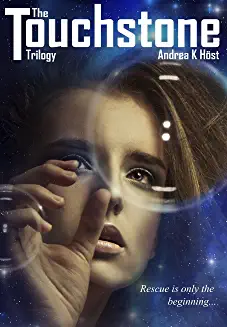
Hands down my favorite self-published-only author. It’s not even close. No doubt you all knew that already, what with Andrea K Host Week here a few years ago. Huh, maybe more than a few years. Wow, how time flies. If you weren’t here for AKH week, click through and read the posts. And recall that AKH is also writing, contemporary romance, more or less … under the name … what is it again … oh, right: Karan K Anders. She’s working on the sequel to that one now and I personally really hope it comes out this year. I wish she would just quit whatever else she’s got going on in her life, become a hermit, and write a lot of books really fast. Oddly, my favorite authors seldom seem inclined to do that. For anyone new to AKH, I have to suggest The Touchstone Trilogy. I don’t think it’s her best — that may be The Pyramids of London for fantasy and of course And All The Stars for SF. But Touchstone is the one I’ve read a million times and listened to twice.
2) Nathan Lowell. I think he’s an obvious choice. He’s been writing for a while, his books were good to start with, and some of his later ones are truly excellent and lots of fun, especially The Wizard’s Butler if you happen to want a low-stress fantasy novel. And these years, who doesn’t? Here’s my review.
3) Lindsay Buroker. Another obvious choice. She’s been around for a while, she’s still going, and she’s good. Her plotting is not always entirely believable, but her dialogue is snappy and delightful. I found her via The Emperor’s Edge series, which I have read several times. Here’s my initial review of the first book.
Everyone at the panel, I think, had heard of Nathan Lowell and Lindsay Buroker. After that, I don’t think we had any names where we overlapped. I’ll do mine first, then Jan’s, then one or two that came from someone else.
4) Victoria Goddard, for The Hands of the Emperor. I mean, obviously. I have not been as delighted by her other books. I am waiting with great anticipation for the actual direct sequel.
5) Alice Degan / AJ Demas, also obviously. From All False Doctrine was published under the first of those names, and as you may recall, this and Goddard’s book were my two favorite novels that I read that year. Here’s my review of From All False Doctrine. Under the name AJ Demas, she’s writing those delightful historicals set in an alternate Greece, such as One Night in Boukos. Here’s my review of that one.
6) JM Ney-Grimm, who as you may know, I’m just starting to read, but I’ve liked the one and a quarter books of hers that I’ve read so far. The one is of course The Tally Master, and here is my review of that one.
7) Alma Boykin, whom one of you mentioned for this topic and who I now want to try on the strength of your description. “Sort of rerunning the late medieval history of Central Europe” and so on, which sounded interesting. Here’s one: Merchant and Magic.
Tycho Rhonarida Galnaar trades hides—hides tanned, hides untanned, with and without fleeces, nothing risky. He prefers steady, low-key trade, a quiet home life, and reliable business partners. … [But] Tycho’s secret—his absolute inability to work or even see magic in a world that depends on it—may be the key to solving a mystery, and saving a city. I haven’t read it, but reviews look good.
8) MCA Hogarth, who I hadn’t realized was self-publishing, but turns out she is! I liked her Mindtouch series quite a bit. A nice, quiet series.
9) Sabrina Chase, with The Last Mage Guardian and the space opera Sequoyah trilogy Here’s my review of the latter.
10) Mikki Samak / Michaela Ro — writing Light in Dark Places under the first name and The Magpie Chronicles under the second. I haven’t read anything by her, but since someone here suggested her, I’m certainly interested. Let’s pause and take a look at each:
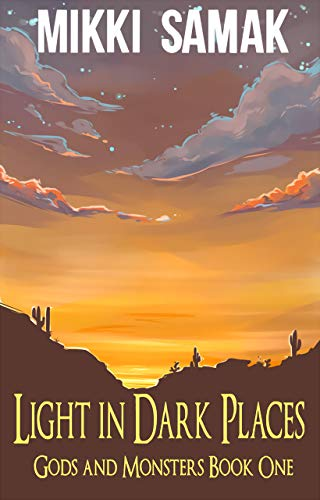
Joan Kaas wakes up seven years after Misery took her. No one can explain why. No one has ever woken up from Misery before. She learns that while she slept, her older sister Seung-ri overthrew a corrupt regime and is now a King, possessing a rare Prodigy-Class Ash talent, all to protect Joan while she slept. Joan doesn’t know why she woke up, why she knows things she never learned before Misery took her, what her Ash talent is, or whether or not she’s her sister’s happy ending or her sister’s tragedy. But she knows Seung-ri has a lot of enemies.
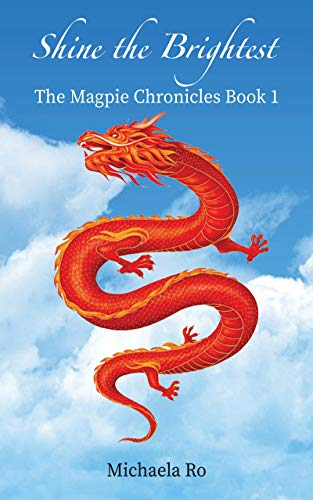
The Red Dragon has been betrayed. Akaryu Masaomi is rightfully one of six rulers of the celestial world’s elaborate and repressive administration, and has taken his powers and privileges for granted all his life, but he has been framed for treason, stripped of his lands, and thrown in prison. Now, trapped in human form and without allies, all he can do is wait for his execution in the most secure prison in the land of Tenou.
Oh, look, a prison break! You know, I’ve always liked that particular trope.
11) Ankaret Wells, whom I also haven’t read anything by. One of you mentioned The Maker’s Mask. Here’s a snippet of description:
Tzenni Boccamera wasn’t a soldier or a diplomat. She was an engineer. But when Tzenni’s sister Catha was captured by soldiers from a rival Spire, there was no one else to go to Catha’s rescue. Tzenni didn’t expect the rescue to involve a sarcastic bodyguard, a plot to bring down the Spire, or an alien species. And she certainly hadn’t meant to fall in love…
I’ll be darned, look at that, that’s another trope I particularly like! Bodyguards! Okay, is Tzenni REALLY an engineer? Does that impact the story? Does she have engineering knowledge she puts to use? Because if so, I’m particularly likely to pick this one up.
12) Skyla Dawn Cameron, another author I don’t know. Looks like she has several series out. I’ll pick one at random … okay: Solomon’s Seal. Here’s part of the description:
Just as her daughter’s private school tuition cheque bounces, Livi gets an offer that could be the break she needs to return to some semblance of her former life. A powerful man wants her to travel to Ethiopia and retrieve the Seal of Solomon—a mythical ring said to control demons and djinn—and this bounty comes with one hell of a financial pay off. … The deadline: a week. The team: unreliable. The competition: her world-renowned archaeologist older brother. Nothing Livi can’t handle… Except the danger goes beyond a few subterranean serpent-dragons she might encounter or tangling with her employer’s deadly second-in-command. This client isn’t all he seems, and handing him the ring might be worse than what he’ll do to her—and her daughter—if she doesn’t.
This does sound promising!
That’s twelve, which is a nice round number, but I have one more I should have thought of much earlier:
13) Gillian Bradshaw, who of course is well known for traditionally published historicals, but her self-published fantasy that starts with Magic’s Poison is really good and also SUPER INTERESTING because of how she divided the protagonist / pov roles. Here’s my review of this series.
Okay! That’s from my list. Now I’m moving to Jan Gephardt’s list:
14) Jennifer Foehner Wells, with her Confluence Series that begins with Fluency
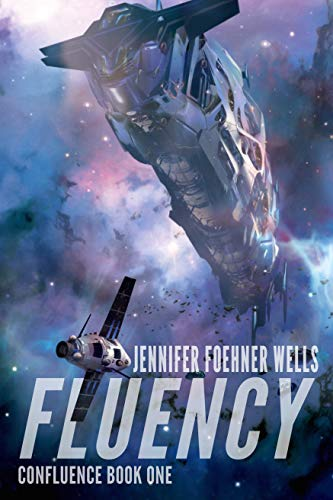
Here’s part of the description:
Dr. Jane Holloway is content documenting nearly-extinct languages and had never contemplated becoming an astronaut. But when NASA recruits her to join a team of military scientists for an expedition to the Target, it’s an adventure she can’t refuse.
The target is a drifting, derelict alien ship that, whoops!, is not as derelict as all that.
15) M. D. Cooper, who also writes space opera, it seems — here’s the first book of her Aeon 14 trilogy.
I’m done with Sol. The system is rotting, and I want out. The Terran Space Force has tried to hold onto me, but even they can’t deny the people behind the largest colony ship ever made. The GSS Intrepid can house millions of colonists, and its leaders have selected me as one of them. I finally have a way out of Sol. Except…there’s a catch.
16) AK DuBoff, who once again writes space opera! I’m sensing a theme to these recommendations. That’s great, as mine were very fantasy-heavy. This list expands recommendations to more thoroughly cover SF as well as F. Here’s the first book of her Taran Empire series, Empire Reborn.
With the future of the Empire hanging in the balance, Jason must find a way to unite the Taran worlds, including the lost colony of Earth, against the mounting threat. There’s just one problem: how do you fight an enemy you can’t see or touch?
17) Cheree Alsop, with — yes — another space opera: her Girl from the Stars series.
Life had never been easy for Liora Day – a half-human, half “mess-with-her-and-you’ll-die” Damaclan. She had been thrown onto a rough path at a very early age, and she didn’t get along with others. That all changes when she is broken out of a cage by Devren, a young captain of the SS Kratos. He shows her that not all humans are heartless.
And Jan notes that all those authors and titles are discussed more extensively at her blog post on Indie Women of SFF, which you can read here. I’ve pulled some description from that post, but click through to read the whole thing.
One more, and this time I don’t recall who mentioned this name:
18) Celia Lake, who’s written, looks like historical fantasy, the Charms of Albion duology.
Alysoun wants more than duty. Born into the aristocratic circles of Albion’s upper class, Alysoun has done everything expected of her. She has married well, produced two healthy children, and handled her social obligations with grace. It’s not enough. Her husband is kind but distant, and she lives with ongoing mysterious pain. Worst of all, she is frankly bored. When Alysoun spots something odd in a stained glass exhibition at the museum, she seizes the opportunity. Perhaps it will finally give them something to talk about.
Richard lives for honour. As a captain of Albion’s Guard, he spends his days solving problems. As Lord of the land, he makes sure his estates in England are thriving. It leaves little time for anything else, even his wife or children. He’s sure they understand. He was brought up the same way.
That’s eighteen! Whew! I’m sure I could come up with another eighteen, but on the other hand, I’m sure a lot of you could too! So
19) Your Choice Here
20) Your Other Choice Here
Who are a couple more self-published authors you’d like to add to this list?
Please Feel Free to Share:






The post “Best Indie Authors of SFF” appeared first on Rachel Neumeier.
October 5, 2022
Adult fantasy, YA protagonist
So I was thinking of this recently because of this book I’m reading for Kay Kenyon, The Girl Who Fell Into Myth, which comes out early next year.
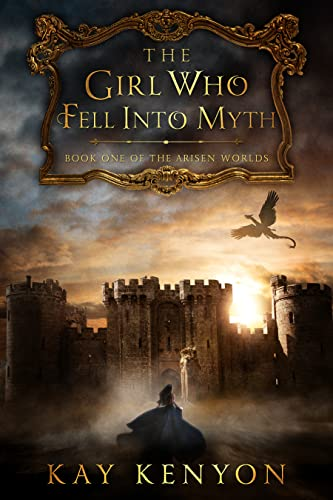
Yevliesza has been caring for her ailing father when she is summoned home to a world she has never seen. Using a hidden portal, she enters the realm of Numinat, a myth world arisen from legend. Although she is the daughter of witches, she was raised in the modern age with little knowledge of their arisen world and none of their magic.
This is an adult fantasy, but as you can guess from this snippet of description, it’s very heavy on YA tropes. The protagonist is maybe late teens, maybe early twenties. She’s taking care of her ailing father. She needs to decide what she wants, she needs to sort out what’s important to her, and she needs to take control of her own life and destiny and make a place for herself in broader society. Quite likely she’ll also fall in love (I’m a third of the way through the book and there’s no romance yet, so I’m not sure).
This is very much a YA novel. Except it’s not; it’s really an adult fantasy. And why? Solely because (I would argue) of the pacing.
One could make a case for YA fantasy being high angst and high romance, while adult fantasy is lower in both departments. But I can think of plenty of counterexamples on each side, so I don’t think that’s it. I think it’s pacing. YA is fast. Adult fantasy can be fast; paranormals and UF are particularly likely to be fast-paced (and also particularly likely to be high in angst and romance), but adult fantasy is often leisurely. It seems to me there are lots of examples of adult fantasy that look in every way like a coming-of-age YA story, except that they’re presented as adult. They’re all slower paced. They may also have deeper worldbuilding, because there’s room for that, because they’re slower paced. Some also have more complicated, multi-dimensional plotting, but not all.
For example:
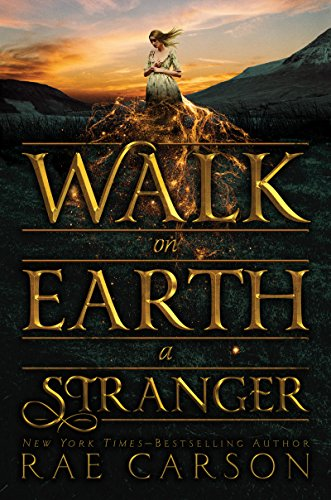
Walk on Earth a Stranger is the first book of a (very good) historical fantasy. It’s definitely YA in all its basic plot elements and tropes.
Lee Westfall has a secret. She can sense the presence of gold in the world around her. Veins deep beneath the earth, pebbles in the river, nuggets dug up from the forest floor. The buzz of gold means warmth and life and home—until everything is ripped away by a man who wants to control her. Left with nothing, Lee disguises herself as a boy and takes to the trail across the country. Gold was discovered in California, and where else could such a magical girl find herself, find safety?
A girl disguises herself as a boy and travels across the country, finding love as well as finding out what kind of person she wants to be. She grows up and begins to build a life for herself. The journey is slow. Everything else is YA. I really loved this trilogy — here are my comments from the first time I read the first book.
I can’t ever think of the above title without immediately thinking of this one, which I read at about the same time and which is also set in an alternate Old-West kind of setting:
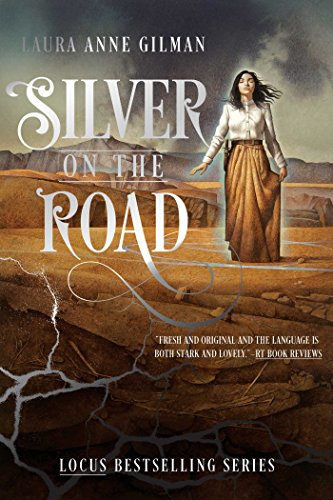
Silver on the Road is the excellent first book of a series that (sorry) I kind of thought dropped off at the end. I didn’t think the third book actually felt much like a conclusion, for quite a few reasons. But the first book is really good! Here are my comments about this one.
Isobel, upon her sixteenth birthday, makes the choice to work for the Boss called the Devil by some, in his territory west of the Mississippi. But this is not the devil you know. This is a being who deals fairly with immense—but not unlimited—power, who offers opportunities to people who want to make a deal, and they always get what they deserve. But his land is a wild west that needs a human touch, and that’s where Izzy comes in.
This book is very definitely YA, except that it’s very, very slow-paced. Also, there’s no romance at all, which is rare (but not unknown) in YA.
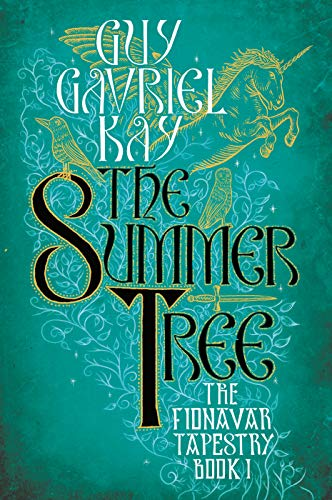
The Fionavar trilogy is one we’ve probably all read, correct?
It begins with a chance meeting that introduces [five college students] to a man who will change their lives: a mage who brings them to the first of all worlds, Fionavar. In this land of gods and myth, each of them is forced to discover what they are and what they are willing to do, as Fionavar stands on the brink of a terrifying war against a dark, vengeful god…
They’re all college students when the series opens. They’re YA-age protagonists dropped into a fantasy world. Why was this trilogy not published as YA? Three reasons. First, it came out in 1984, which was just about when YA was becoming a thing and just before YA became a BIG thing. Second, it’s slower-paced than most YA, at least for large sections. And five protagonists makes for more complicated plotting; that may be an element in how this trilogy was marketed and perceived. But it’s not just the age of the protagonist. They all grow up and sort out their lives, in a very YA manner. Well, not Kevin, but the rest of them.
It seems to me there are lots of fantasy novels that basically fall into this category. That is, maybe, partly, because a lot of authors default to a late teens / early twenties protagonist and then they’re almost compelled to make the story a coming-of-age story no matter what else they’re doing with that story.
It also seems to me that this is yet another reason of the many that YA as a category is a pretty terrible category. It trains readers to expect and want a fast pace at the expense of a more thoughtful, leisurely pace or deeper worldbuilding. Insist on a fast pace for YA for twenty years and boom, you start hearing comments about how adult SF is taking on many of the characteristics of YA — more angst, more romance, faster pace — and that there’s less room for fantasy novels that don’t have those characteristics. What a shocker that is. I don’t think this has anything to do with social media and short attention spans. I think it has everything to do with what young readers have been taught to expect.
I hereby suggest, possibly not for the first time, that young readers, parents, and librarians quit worrying about whether a novel is YA and start offering a lot more emphatic nudges toward adult novels that would suit individual young readers looking for stuff to read. The Fionavar trilogy was published 38 years ago (I KNOW, I don’t believe that either). Lots of young readers probably haven’t read it. Pull it out and stuff it into their hands. GGK is such a splendid writer, and this trilogy remains a great entry into his work, especially for someone who already enjoys YA fantasy.
Please Feel Free to Share:






The post Adult fantasy, YA protagonist appeared first on Rachel Neumeier.
October 4, 2022
Fantasy + Mystery/Detective Fiction
This is a post by James Davis Nichol:, which starts this way:
I recently happened across a Twitter conversation in which an author asserted, with the unwavering confidence of a person about to denounce the heliocentric model of the Solar System, that mystery/detective/police or legal procedurals are antithetical to horror/fantasy. This is a claim for which I am grateful. My quest for inspiration is endless and nothing serves me quite as well as a bar so low it requires a trench.
I laughed. A bar so low it requires a trench! I’m going to remember that one.
Of course that’s a ridiculous assertion, so ridiculous that I’m surprised anyone offered it as a hypothesis, never mind asserting it as a statement of fact. I instantly think of, eg, Lord Darcy ">Lord Darcy. I will add, these are too … how shall I put this … too Sherlockian to appeal to me. They’re all about the clever plot, which is not what I like in mysteries. But they are most definitely fantasy stories that are also detective fiction.
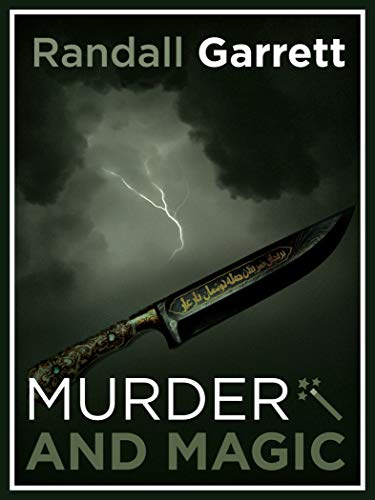
I don’t know whether Nicholl mentions them, but he’s always recalling older SFF, so probably! Let me look … no, he doesn’t. But after all, there are zillions of examples of fantasy/detective novels. Here’s one he does mention:
Point of Hopes by Melissa Scott and Lisa A. Barnett
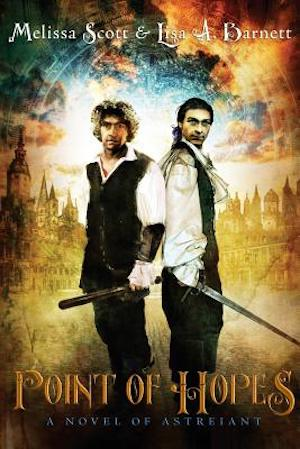
The great city of Astreiant and the monarchy of Chenedolle to which it belongs recognize the rule of law…in rudimentary fashion. However, there does exist a cadre of professionals charged with enforcing such laws as exist. Pointsman Rathe is one such professional. What begins as a simple missing-persons case is revealed to be a problem of far grander scale: all across the city, children are vanishing. The straightforward folk of Astreiant default to blaming the first scapegoats who come to mind. Rathe, for his part, actually cares about the truth. It’s not at all clear that he will be able to uncover the truth in time to save the children.
This one is much heavier on the fantasy and much lighter on the detective fiction vibe. Also lots more emphasis on the characters. Nothing Sherlockian about it. I liked it a lot.
Nicholl lists off a handful of others — not many, but a wide range.
There are so many others, and a tremendously wide range if you include every kind of mytery. Let me try to think of a few that aren’t just mysteries, but are specifically detective fiction. All right, here’s one: The Eyre Affair —
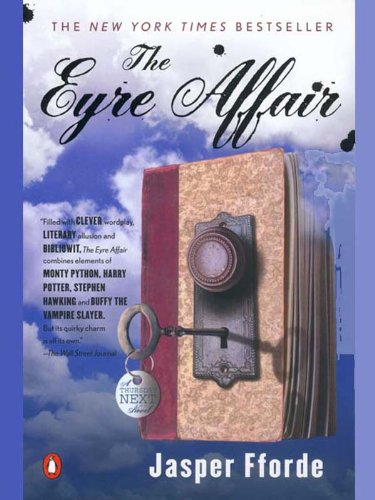
Which is in a class of its own for a zillion reasons. When someone begins kidnapping characters from works of literature and plucks Jane Eyre from the pages of Brontë’s novel, Thursday is faced with the challenge of her career. … Her career as a detective, of course.
And Jackaby by Ritter is another.
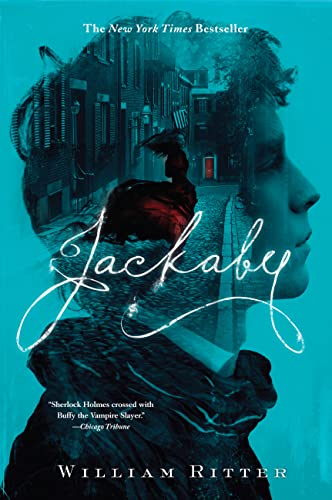
I liked this one quite a bit. I see there are three others in the series. Maybe I should try the next. Although I kind of have enough books to read right now, I have to say. And for me, detective fiction can be nice to read, but isn’t likely to be really emotionally engaging. Too much intellectual working out the crime, not enough sinking into the story … here’s one that might be an exception, though: Tamora Pierce’s Beka Cooper series.
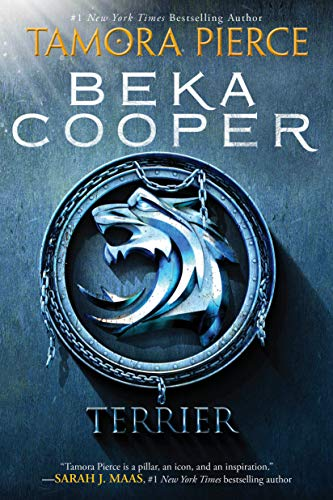
A very good trilogy, and here we have a cop at the beginning of her career, in a world where cops and detectives are a pretty new idea. I’d say that really, this trilogy straddles the distance between detective fiction such as the Lord Darcy stories, and fantasy-with-detective-elements such as Point of Hopes. Lots of worldbuilding here, lots of emphasis on the characters. I liked this series a lot and I’ve read it several times.
Anyway, there’s no end. I’m sure we could think of dozens if not hundreds of books that are both fantasies and detective novels / mysteries. That really IS a bar so low you have to dig a trench.
Please Feel Free to Share:






The post Fantasy + Mystery/Detective Fiction appeared first on Rachel Neumeier.
October 3, 2022
Update: Tasmakat
All right, so I really thought I’d have nothing to say this morning.
a) I spent a lot of time last week reading The Golden Enclaves (which was fantastic, yay!)
b) I spent practically all of Saturday at Archon (which was perfectly fine, and I greatly appreciate all your suggestions for the panels!)
c) Have I mentioned that I’m taking my mother to physical therapy a couple times a week? She’s doing okay, but that has a big impact on how much time I have in the morning.
d) The dratted biology class. I will (probably) complain about it less in another week or so, after we hit mitosis/meiosis/genetics, particularly genetics. I really love genetics! But at the moment, do you realize I was compelled to assign a lab report? (It’s in the syllabus.) (I know, I could have taken it out, but I guess it’s okay to provide this one experience in writing a lab report, plus some students could really use the extra points in a take-home assignment.) (But now I’m going to have to grade the dratted thing. It will take hours to grade 20-plus lab reports, and they will be much more boring than, say, an equal number of English Comp I essays.)
However, all that aside, I actually made a lot of progress on Tasmakat! That’s because I wrote almost 9000 words on Sunday.
Wow, you may be saying, I bet that means Rachel finally wrote the big revelation scene where we find out the truth about certain important things!
No. I thought I was going to, but instead I wrote a scene that I didn’t see coming, plus associated scenes.
I won’t tell you anything about it, except that Aras snaps, “You stubborn Ugaro, I won’t let you do something you so vehemently don’t want to do!” And Ryo answers, with just as much force, “You arrogant Lau, I will not permit you to make a decision that rightfully belongs to me!”
So that was a tense moment. Aras walked out and Ryo made his own decision, and then we moved on with the consequences of that.
And this morning, I finally began the big revelation scene. I jumped over a hopefully short transition scene to get to it. I’m going to try a new strategy this week: on weekdays, jump over everything transitional, everything doubtful, everything I’m not sure about, and write the scenes that I most want to write. Then go back on the weekend and fill in the transitional material and figure out the difficult stuff. I think — I hope — that will mean I get more done per week. Here we are in October! I would LOVE to be writing THE END by the end of this month, or at least pretty close to it.
Other things that are taking time: I’m also beta-reading another book for Sherwood Smith, the third book of the Norsunder War series, and reading an unpublished book for Kay Kenyon with an eye to providing a blurb, and wow, I just feel really busy right now.
Oh, I’ll comment a bit about the above two books:
Sherwood Smith’s series is omniscient viewpoint and we get roughly a thousand different points of view. I’m much more engaged with some than with others. I’ve read a good many recent books in this huge set of linked series, so I’m deeply invested in some of the plotlines, while I care a lot less about others. However, the second book hit many, many buttons for me with a whole bunch of my favorite characters, so I’ve been looking forward very much to the third book. It’ll be four books total, I believe. I bet I see the fourth this year. She’s very fast.
Kay Kenyon’s book is interesting because I picked it up while writing all these posts on Positive Fantasy. This is totally not that, and it’s been, as I say, interesting. I found myself thinking very explicitly, “Are these people EVER going to be NICE to each other?” The answer is, as far as I can tell, is basically no. However, the main character has now discovered she has magic powers, and some people around her are at least looking like they might become allies, though personally I wouldn’t trust any of them as far as I could throw them at this point.
Great cover, I will add:
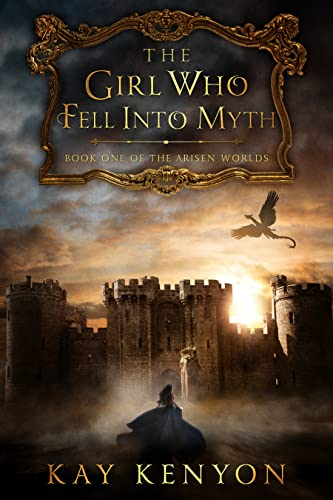
It’s one of those novels that’s very YA, but too slow paced for YA, so it’s adult fantasy. I ought to write a post about that, because there are quite a lot of fantasy novels that I think fit that description — YA but slow paced. Anyway, hopefully I’ll wind up really enjoying this book. I’ll certainly let you all know if so.
Please Feel Free to Share:






The post Update: Tasmakat appeared first on Rachel Neumeier.



